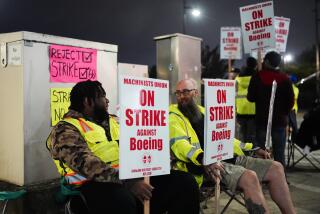Column: The day when three NASA astronauts staged a strike in space
- Share via
Blows on behalf of fair labor treatment don’t always have to come from factory workers. Sometimes they’re delivered by unionized professors or even multimillionaire ballplayers. On Dec. 28, 1973, or 42 years ago Monday, one was delivered by three U.S. astronauts orbiting the globe in NASA’s Skylab -- a one-day sit-down strike in space.
As Erik Loomis retells the story, mission commander Jerry Carr, science pilot Ed Gibson and pilot William Pogue were in the midst of what would become a record 84-day mission, the last before the spacecraft was to be decommissioned, when they rebelled against NASA’s remorseless work schedule.
We would never work 16 hours a day for 84 straight days on the ground, and we should not be expected to do it here in space.
— Skylab 4 Commander Jerry Carr to NASA, just before the crew went on strike
They knew before going up that the pace would be punishing -- 84 days of 16 hours each without a break, filled with minute-by-minute scheduling for observations of the sun and Comet Kohoutek, medical tests, photographing of the Earth below, and four spacewalks.
Other astronauts on the ground team, including the commanders of the previous two Skylab missions, advised NASA that the plans were unreasonable. None of the three astronauts on the Skylab 4 mission had been in space before, but NASA hadn’t factored in any time for them to become acclimated to conditions aloft. They were plainly overscheduled. In fact, Pogue almost immediately came down with debilitating nausea.
Join the conversation on Facebook >>
Relations between the crew and mission control started off on the wrong foot. The crew treated Pogue’s spacesickness as a passing bug (they were right) and didn’t bother to report it to Houston, which turned out to be secretly eavesdropping on their onboard conversations and upbraided them for keeping secrets.
Almost instantly the crew fell behind schedule, and with no give in the workload, couldn’t catch up. After a month, Gibson was grousing that the mission resembled “a 33-day fire drill.” Carr informed ground control, “We would never work 16 hours a day for 84 straight days on the ground, and we should not be expected to do it here in space.”
The crew gained the reputation of “complainers,” and their exchanges with Houston lost their civility. Finally, a couple of days after Christmas, Carr wired a manifesto earthward: “We need more time to rest. We need a schedule that is not so packed. We don’t want to exercise after a meal. We need to get things under control.”
Houston’s response was chilly: The crew had to meet its schedule. On Dec. 28, the crew staged its strike. (In some accounts, it’s called a “mutiny,” which is surely too harsh.) Carr turned off the radio link with the ground and crew members spent a full day relaxing, taking things at their own pace and pursuing projects of their own.
The ground crew, stuck at the far end of a dead radio hookup, had no choice but to fume impotently. When Skylab came back online, NASA was much more amenable to discussion. Houston agreed to afford the crew full rest and meal breaks, and replace its minute-by-minute schedules with a list of tasks to be completed, leaving it to the crew to manage its own time.
Interspace relations improved from then to the end of the mission in February, but the crew’s strike plainly rankled; none of the three ever was assigned a spaceflight again. Pogue, who died last year, danced around the episode in his 2011 memoir, “But for the Grace of God,” mentioning that the Skylab work was “sometimes tiresome and tedious, but the view was spectacular.” Asked at a post-mission debriefing how he and his crew mates got along, he recollected, he replied: “We got along together just fine. We were bound by a common enemy: Mission Control.”
But the one-day strike did force a lasting reconsideration of crew management upon NASA, contends Samir Chopra of Brooklyn College. NASA treated the crew as expendable instruments of its schedule, but Skylab 4 showed that when push came to shove the astronauts had all the control in their own hands.
Once in space, they were no longer replaceable robots and had to be treated as responsible partners if the mission was to be completed successfully. “Highly trained military types and scientists fully convinced of the value of their work are likely to push back when placed in an artificially controlled, too-tightly-regulated environment,” Chopra observed. “The lessons here are not just for manned space flight, but for any workplace environment that approximates its conditions, whether in space or on Earth.”
Loomis concludes, however, that the lessons of Skylab 4 have limited application. It’s not common for employees to have the control over management that the crew could exercise merely by turning off their radio, threatening work valued a millions of dollars a day. There wasn’t much to be learned even by 1970s labor activists from the strike in space.
“It’s hard to make new demands of employers when those employers are just going to move the jobs to Mexico, as was happening throughout the 1970s,” Loomis writes. Union organizing was heading into a dark age then, the Skylab strike notwithstanding, thanks to “the rise of conservatism and the growth of the powerful corporate lobby with the open intent of crushing the American labor movement,” he adds. We’re still living with the consequences.
Keep up to date with Michael Hiltzik. Follow @hiltzikm on Twitter, see our Facebook page, or email [email protected].
MORE FROM MICHAELHILTZIK:
Admit it: ‘Star Wars: The Force Awakens’ stinks -- and here’s why
A look at healthcare changes in 2015 and beyond
Martin Shkreli was one terrible investor, SEC document shows
More to Read
Inside the business of entertainment
The Wide Shot brings you news, analysis and insights on everything from streaming wars to production — and what it all means for the future.
You may occasionally receive promotional content from the Los Angeles Times.











